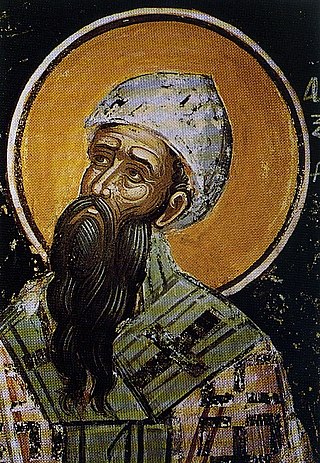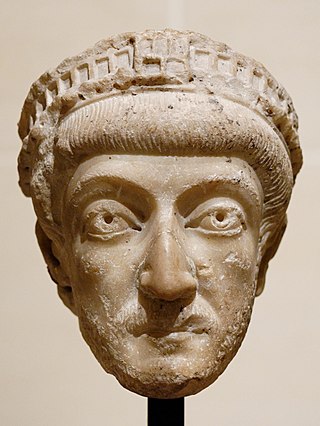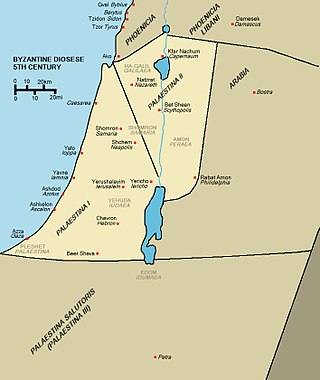Related Research Articles

Ambrose of Milan, venerated as Saint Ambrose, was a theologian and statesman who served as Bishop of Milan from 374 to 397. He expressed himself prominently as a public figure, fiercely promoting Roman Christianity against Arianism and paganism. He left a substantial collection of writings, of which the best known include the ethical commentary De officiis ministrorum (377–391), and the exegetical Exameron (386–390). His preachings, his actions and his literary works, in addition to his innovative musical hymnography, made him one of the most influential ecclesiastical figures of the 4th century.

Cyril of Alexandria was the Patriarch of Alexandria from 412 to 444. He was enthroned when the city was at the height of its influence and power within the Roman Empire. Cyril wrote extensively and was a major player in the Christological controversies of the late-4th and 5th centuries. He was a central figure in the Council of Ephesus in 431, which led to the deposition of Nestorius as Patriarch of Constantinople. Cyril is counted among the Church Fathers and also as a Doctor of the Church, and his reputation within the Christian world has resulted in his titles Pillar of Faith and Seal of all the Fathers. The Nestorian bishops at their synod at the Council of Ephesus declared him a heretic, labelling him as a "monster, born and educated for the destruction of the church."

Theodosius I, also called Theodosius the Great, was Roman emperor from 379 to 395. During his reign, he succeeded in a crucial war against the Goths, as well as in two civil wars, and was instrumental in establishing the creed of Nicaea as the orthodox doctrine for Christianity. Theodosius was the last emperor to rule the entire Roman Empire before its administration was permanently split between two separate courts.

The Sanhedrin was an assembly of either 23 or 71 elders, appointed to sit as a tribunal in every city in the ancient Land of Israel.

The Damascus affair of 1840 refers to the arrest of several notable members of the Jewish community in Damascus on the accusation of murdering Father Thomas, a Christian monk, and his Muslim servant for the purpose of using their blood to bake matzo, an anti-semitic accusation also known as the blood libel.

Gamaliel the Elder, or Rabban Gamaliel I, was a leading authority in the Sanhedrin in the early first century CE. He was the son of Simeon ben Hillel and grandson of the great Jewish teacher Hillel the Elder. He fathered Simeon ben Gamliel, who was named for Gamaliel's father, and a daughter, who married a priest named Simon ben Nathanael.

The Davidic line or House of David refers to the lineage of the Israelite king David through texts in the Hebrew Bible, the New Testament, and through the succeeding centuries.

The Codex Theodosianus was a compilation of the laws of the Roman Empire under the Christian emperors since 312. A commission was established by Emperor Theodosius II and his co-emperor Valentinian III on 26 March 429 and the compilation was published by a constitution of 15 February 438. It went into force in the eastern and western parts of the empire on 1 January 439. The original text of the codex is also found in the Breviary of Alaric, promulgated on 2 February 506.
History of European Jews in the Middle Ages covers Jewish history in the period from the 5th to the 15th century. During the course of this period, the Jewish population gradually shifted from their homeland in the Levant to Europe, primarily Central Europe dominated by the Holy Roman Empire or Southern Europe dominated by the Iberian kingdoms.
Nasi is a Hebrew title meaning "prince" in Biblical Hebrew, "Prince [of the Sanhedrin]" in Mishnaic Hebrew, or "president" in Modern Hebrew.

The history of the Jews in Cyprus dates back at least to the 2nd century BC, when a considerable number of Jews in Cyprus was first recorded. The Jews had close relationships with many of the other religious groups on the island and were seen favourably by the island's Roman rulers. During the war over the city of Ptolemais between Alexander Jannaeus and King Lathyros, many Jews remained committed to King Lathyros and were subsequently killed.

Palæstina Secunda or Palaestina II was a Byzantine province from 390, until its conquest by the Muslim armies in 634–636. Palaestina Secunda, a part of the Diocese of the East, roughly comprised the Galilee, Yizrael Valley, Bet Shean Valley and southern part of the Golan plateau, with its capital in Scythopolis. The province experienced the rise of Christianity under the Byzantines, but was also a thriving center of Judaism, after the Jews had been driven out of Judea by the Romans in the 1st and 2nd centuries.

Christianity began as a Second Temple Judaic sect in the 1st century in the Roman province of Judea, from where it spread throughout and beyond the Roman Empire.
The history of the Jews in the Byzantine Empire has been well recorded and preserved.
Pieter Willem van der Horst is a scholar and university professor emeritus specializing in New Testament studies, Early Christian literature, and the Jewish and Hellenistic context of Early Christianity.

Christianity became the official religion of the Roman Empire when Emperor Theodosius I issued the Edict of Thessalonica in 380, which recognized the catholic orthodoxy of Nicene Christians in the Great Church as the Roman Empire's state religion. Most historians refer to the Nicene church associated with emperors in a variety of ways: as the catholic church, the orthodox church, the imperial church, the imperial Roman church, or the Byzantine church, although some of those terms are also used for wider communions extending outside the Roman Empire. The Eastern Orthodox Church, Oriental Orthodoxy, and the Catholic Church all claim to stand in continuity from the Nicene church to which Theodosius granted recognition.
The religious policies of Constantius II were a mixture of toleration for some pagan practices and repression for other pagan practices. He also sought to advance the Arian or Semi-Arianian heresy within Christianity. These policies may be contrasted with the religious policies of his father, Constantine the Great, whose Catholic orthodoxy was espoused in the Nicene Creed and who largely tolerated paganism in the Roman Empire. Constantius also sought to repress Judaeism.

In the Iberian peninsula, the crown rabbi was a secular, administrative post occupied by a member of the Jewish community for the benefit of the governing state, and existed in the kingdoms of Castile, Aragon, Navarre and Portugal as far back as the 13th century, and is referred to as crown rabbi by historians in English, as well as by court rabbi and other terms.
The Tascodrugites were a sect active in Galatia in the fourth and fifth centuries AD, and possibly as late as the ninth. Ancient sources present them variously as Gnostics or heterodox Christians. Most likely they were Montanists.
References
- Graetz, Heinrich (1898). History of the Jews. Vol. 2. Philadelphia: Jewish Publication Society.
- Pharr, Clyde (1952). The Theodosian Code and Novels and the Sirmondian Constitutions. Princeton: Princeton University Press.
- Niedermann, Maximillian; Liechtenhan, Eduard, eds. (1968). Marcelli De Medicamentis Liber. Corpus Medicorum Latinorum. Vol. 5 (2nd ed.). Berlin: Akademie Verlag.
- van der Horst, Pieter Willem (2002). "The Last Jewish Patriarch(s) and Graeco-Roman Medicine". Japheth in the Tents of Shem: Studies on Jewish Hellenism in Antiquity. Contributions to Biblical Exegesis & Theology. Vol. 32. Leuven: Peeters Publishers.